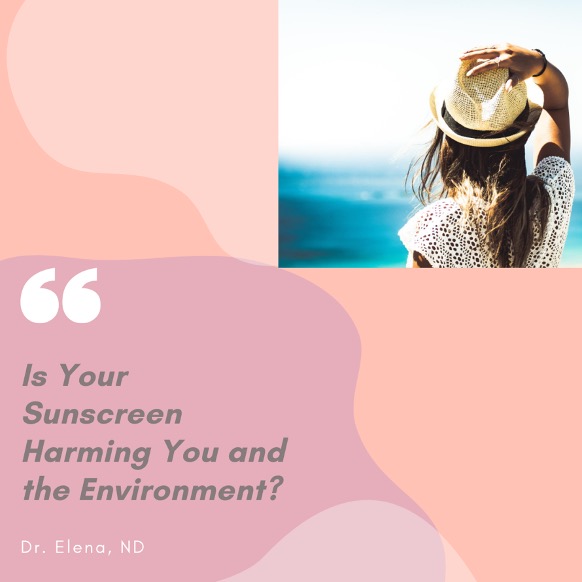
As we enjoy these sunny, warmer days in Vancouver, I thought it was crucial to discuss the importance of choosing the right sunscreen for our health.
As the rate of skin cancer increases worldwide, many of us have become more diligent about applying sunscreen before leaving our homes during the summer. So, what are the available options in the sunscreen market?
- Organic/ Chemical Filters– are the most widely available and used products. Some examples of these ingredients include Octyl methoxycinnamate, Benzophenone, Methylbenzyli-dine camphor, Octocrylene, Oxybenzone, not to mention tons of perfumes and fragrances these products contain to make them more marketable.
These products can easily be absorbed through our skins, and because they are fat-soluble, they can accumulate in our livers, brains and adipose tissues. In-vivo and in-vitro studies have shown that these chemicals act as endocrine disruptors as they affect various hormones productions due to disrupting communication and signalling between our endocrine glands such as hypothalamus, thyroid, adrenal glands, ovaries and testes.
These may lead to low production of certain hormones while increasing others, which may lead to common concerns such as Hypothyroidism, Polycystic Ovarian Syndrome (PCOS), sexual dysfunctions and fertility issues. Additionally, they may have long-term effect on motor functions of animals and humans alike according some recent studies looking at neurodegeneration in animal models. Yikes! if you still use this type of sunscreen, it may be time to look for safer alternatives.
- Inorganic/Physical Filters– are made up of metal oxide ingredients such as titanium dioxide (TiO2) and Zinc oxide (ZnO). TiO2 provides UVB protection, while ZnO mainly absorbs UVA range, so the combination provides a full spectrum protection.
Initially, there were some concerns about unknown long-term impact of nano particulates from these filisters in humans. A 2020 Australian study looking at absorption rate of these particulates by volunteers showed that they are unlikely to penetrate the outermost layer of skin in humans and thereby confirming their safety. That said, some cons with majority of these products currently available on the market include overly greasiness and white cakey appearance on the surface of skin upon applications.
Hopefully, as more companies start switching production to the physical filters, they can work out the tweaks and make application of these products more efficient.
So, in summary the bottom line based on available research is:
🌞 Physical filters (ZnO and TiO2) seem to be a far safer mode of broad-spectrum UV protection as compared to traditional organic counterpart containing Oxybenzone and others listed above.
🌞 Physical barriers such as long-sleeved shirts, pants, hats, and staying in shade during the peak hours are still super important.
🌞 Don’t forget to reapply your sunscreen every 2 hours and right after a swim or outdoor workout or towel drying your body even if the label claims that the products is sport proof.
PMID: 31939224, 29981751